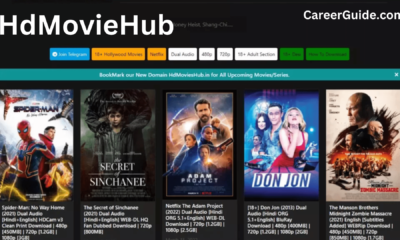Business
Get Ready Bell: Client Pulse
Published
1 month agoon
By
Admin
Get Ready Bell: Client Pulse In today’s fast-paced and ever-evolving business environment, staying in tune with clients’ needs, expectations, and preferences is crucial for success. The concept of “Client Pulse” revolves around continuously monitoring and understanding the dynamic demands of clients to deliver exceptional service and foster long-term relationships. This article delves into the significance of keeping a finger on the client pulse, strategies for effective client engagement, and the tools that can help businesses maintain a competitive edge.
The Importance of Client Pulse
The term “Client Pulse” refers to the ongoing process of gauging client satisfaction, preferences, and feedback. This approach goes beyond traditional customer service by proactively seeking insights to anticipate needs and address concerns before they become issues. Understanding the client pulse is vital for several reasons:
- Enhancing Customer Experience: By regularly monitoring client feedback, businesses can identify areas for improvement and implement changes that enhance the overall customer experience. Satisfied clients are more likely to become repeat customers and advocates for the brand.
- Building Loyalty: Clients appreciate when their voices are heard. Demonstrating that their opinions matter builds trust and loyalty, which are essential for long-term success. Loyal clients are not only more likely to continue using your services but also to recommend your business to others.
- Identifying Trends: Keeping track of client feedback helps businesses identify emerging trends and shifts in preferences. This information can be used to adapt products and services to meet changing demands, giving companies a competitive advantage.
- Preventing Churn: Regularly checking the client pulse allows businesses to identify dissatisfied clients early on. By addressing their concerns promptly, companies can prevent churn and retain valuable clients.
- Driving Innovation: Client feedback often includes suggestions for new features or improvements. Leveraging this feedback can drive innovation and help businesses stay ahead of the competition.
Strategies for Effective Client Engagement
To effectively monitor the client pulse, businesses must adopt a multi-faceted approach that includes various strategies for engaging with clients and collecting feedback. Here are some key strategies to consider:
1. Regular Surveys and Feedback Forms
One of the most direct ways to gather client feedback is through surveys and feedback forms. These tools can be used to solicit opinions on specific aspects of your products or services. To maximize response rates and gather meaningful insights, consider the following tips:
- Keep it Short and Simple: Clients are more likely to complete surveys if they are concise and easy to understand. Focus on asking the most relevant questions.
- Use a Mix of Question Types: Include a variety of question types, such as multiple-choice, rating scales, and open-ended questions, to capture different aspects of client feedback.
- Offer Incentives: Providing small incentives, such as discounts or entries into a prize draw, can encourage clients to participate in surveys.
2. Social Media Engagement
Social media platforms provide a wealth of opportunities for engaging with clients and gathering feedback. By actively monitoring and participating in social media conversations, businesses can gain valuable insights into client sentiment. Here are some effective tactics:
- Monitor Mentions and Hashtags: Use social listening tools to track mentions of your brand and relevant hashtags. This allows you to see what clients are saying about your business and identify trends.
- Respond Promptly: Engage with clients by responding to their comments, questions, and concerns in a timely manner. This shows that you value their input and are committed to addressing their needs.
- Run Polls and Q&A Sessions: Utilize features like polls and Q&A sessions on platforms such as Instagram, Twitter, and LinkedIn to directly ask clients for their opinions and feedback.
3. Customer Support Interactions
Customer support interactions are a goldmine of feedback. Every time a client reaches out for help, it’s an opportunity to learn about their needs and pain points. To make the most of these interactions:
- Train Support Staff: Ensure that your customer support team is trained to ask the right questions and document client feedback accurately.
- Follow Up: After resolving an issue, follow up with clients to ask about their experience and gather additional feedback.
- Analyze Support Data: Regularly analyze data from customer support interactions to identify common issues and areas for improvement.
4. Client Advisory Boards
For a more structured approach to gathering feedback, consider establishing a client advisory board. This group of selected clients can provide in-depth insights and strategic advice. To set up an effective advisory board:
- Select Diverse Members: Choose clients who represent a cross-section of your customer base to ensure a variety of perspectives.
- Hold Regular Meetings: Schedule regular meetings to discuss new developments, gather feedback, and brainstorm ideas.
- Act on Feedback: Demonstrate that you value the board’s input by implementing their suggestions and sharing updates on progress.
5. Data Analytics
Leveraging data analytics is essential for understanding the client pulse at a deeper level. By analyzing client behavior and interactions, businesses can uncover patterns and trends. Key areas to focus on include:
- Website Analytics: Use tools like Google Analytics to track how clients interact with your website. Look for trends in page visits, time spent on pages, and conversion rates.
- Sales Data: Analyze sales data to identify which products or services are most popular and which are underperforming. This can help you understand client preferences and demand.
- Customer Journey Mapping: Create customer journey maps to visualize the various touchpoints clients have with your business. This can highlight pain points and opportunities for improvement.
Tools for Monitoring Client Pulse
Several tools and technologies can help businesses effectively monitor the client pulse. Here are some of the most popular and effective options:
1. Customer Relationship Management (CRM) Systems
CRM systems, such as Salesforce, HubSpot, and Zoho CRM, are essential for managing client interactions and data. These systems allow businesses to track client interactions, gather feedback, and analyze trends. Key features to look for in a CRM system include:
- Contact Management: Store and organize client information in a centralized database.
- Interaction Tracking: Record and track all client interactions, including emails, calls, and meetings.
- Reporting and Analytics: Generate reports and analyze data to gain insights into client behavior and preferences.
2. Survey and Feedback Tools
There are numerous survey and feedback tools available that make it easy to collect and analyze client feedback. Some popular options include:
- SurveyMonkey: A versatile tool for creating and distributing surveys, with robust analytics features.
- Typeform: Known for its user-friendly interface and engaging survey designs.
- Qualtrics: A comprehensive feedback platform with advanced features for survey design, distribution, and analysis.
3. Social Listening Tools
Social listening tools help businesses monitor social media conversations and gather insights from client interactions. Some top social listening tools include:
- Hootsuite: A social media management platform that includes social listening features.
- Brandwatch: A powerful tool for monitoring social media mentions and analyzing sentiment.
- Sprout Social: Provides social listening, engagement, and analytics features.
4. Customer Support Platforms
Customer support platforms can streamline client interactions and provide valuable feedback. Some popular customer support platforms include:
- Zendesk: A widely used platform for managing customer support tickets and interactions.
- Freshdesk: Offers a range of customer support features, including ticket management and analytics.
- Intercom: Combines customer support with marketing automation and engagement tools.
5. Analytics Tools
Analytics tools are essential for understanding client behavior and preferences. Some key tools to consider include:
- Google Analytics: A free tool for tracking website traffic and user behavior.
- Mixpanel: Focuses on analyzing user interactions with web and mobile applications.
- Tableau: A powerful data visualization tool that helps businesses analyze and present data effectively.
Best Practices for Maintaining Client Pulse
Maintaining an accurate and up-to-date understanding of the client pulse requires ongoing effort and commitment. Here are some best practices to help you stay on track:
1. Foster a Client-Centric Culture
Cultivate a culture that prioritizes client satisfaction and values feedback. Encourage all employees, from frontline staff to executives, to take an active role in understanding and addressing client needs.
2. Be Proactive
Don’t wait for clients to come to you with feedback. Proactively seek out their opinions and listen to their concerns. Regularly reach out through surveys, social media, and direct interactions to gather insights.
3. Act on Feedback
Demonstrating that you value client feedback requires more than just listening. Take action based on the insights you gather and communicate the changes you’ve made. This shows clients that their input has a real impact.
4. Continuously Improve
Client expectations and market conditions are constantly changing. Continuously evaluate and improve your processes for gathering and acting on client feedback. Stay agile and be willing to adapt to new trends and technologies.
5. Measure Success
Regularly measure the success of your client engagement efforts. Use key performance indicators (KPIs) such as client satisfaction scores, Net Promoter Score (NPS), and customer retention rates to track your progress.
Conclusion
In the modern business landscape, understanding the client pulse is more important than ever. By continuously monitoring client feedback and staying attuned to their needs, businesses can enhance the customer experience, build loyalty, and drive innovation. Implementing effective strategies for client engagement and leveraging the right tools can help you maintain a competitive edge and achieve long-term success. Remember, a satisfied client is not just a customer; they are an advocate for your brand, and their loyalty is the cornerstone of your business’s growth and prosperity.
You may like

Broadway Shows by Year – Opened in 2023

Medical Billing Process and Practices to Reduce Costs

Andre Hakkak: A Financial Titan’s Journey and Net Worth Breakdown

Michelle Smallmon: A Comprehensive Overview

Revolutionizing Content: The Latest Innovations in Video Dubbing

The Role of Scalp Serum in Treating Scalp Conditions

An Introduction to Lifeguard Classes

Introduction to Appeal Case Preparation

Shop Personalized Heart Bracelets: A Timeless Gift of Love

What is Simp City Forum & How to Use the Forum

What is Evırı? Everything You Need to Know

Maximizing Efficiency and Accuracy with Construction Takeoff and Estimating Services

Comprehensive Guide to Roofing Takeoff Services, Piping Estimating Services, and Drywall Takeoff Services

Unveiling the Mysteries and Benefits
Showcase Of Ark: Survival Evolved (2017) Icons And Banners

Metal Gear Solid 3 Remake: Everything We Know So Far

Los Angeles News and Events

A Guide to a Healthy Life with Well Health Organic

Pedrovazpaulo Executive Coaching

Unlock Your Potential with Pedro Vaz Paulo Coaching

Broadway Shows by Year – Opened in 2023

Medical Billing Process and Practices to Reduce Costs

Andre Hakkak: A Financial Titan’s Journey and Net Worth Breakdown

Michelle Smallmon: A Comprehensive Overview

Revolutionizing Content: The Latest Innovations in Video Dubbing

The Role of Scalp Serum in Treating Scalp Conditions

An Introduction to Lifeguard Classes

Introduction to Appeal Case Preparation

Shop Personalized Heart Bracelets: A Timeless Gift of Love








